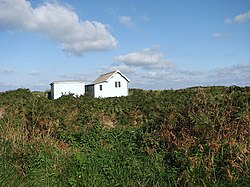Eccles on Sea
| Eccles-on-Sea | |
| Norfolk | |
|---|---|
 Cottage above the beach, Eccles on Sea | |
| Location | |
| Grid reference: | TG407292 |
| Location: | 52°48’25"N, 1°34’12"E |
| Data | |
| Local Government | |
| Council: | North Norfolk |
Eccles-on-Sea (also called Eccles-by-the-Sea) is an ancient Norfolk coastal fishing village, now virtually all swept into the North Sea.
History
The placename Eccles comes from the Latin ecclesia meaning church, and usually indicates an early British Christian site, as ecclesia was not taken into the Anglo-Saxons' vocabulary, other than in inherited place names. When the Domesday Book was compiled in 1086, Eccles-on-Sea was a thriving community of some 2,000 acres, but as it was situated in a low-lying area on the North Norfolk coast it was prone to inundation.
In 1605, according to William White's History, Gazetteer, and Directory of Norfolk, 1883, the inhabitants petitioned for a reduction in their taxes when only 14 houses and 300 acres remained following a ferocious storm in 1604.[1]
By 1881 the village had only 17 inhabitants and comprised 253 acres, divided into two farms.[1]
Today the majority of the area is occupied by the Bush Estate - a collection of about 200 mostly pre-war bungalows tucked in behind the sand dunes. The Bush Estate was originally a simple holiday retreat, with just one well between the inhabitants and no mains drainage or power.
However, over the years the properties have been improved, the utility companies subsequently laid on mains drainage, electricity and telephones and the community took on a more permanent feel. Today about half the dwellings are occupied all year round and many of the more temporary structures have been rebuilt as conventional bungalows.
The community at Eccles is now nestled behind concrete sea defences constructed after the North Sea flood of 1953.
The Church of St Mary’s at Eccles-on-Sea
The tower of St Mary’s Church at Eccles, which was badly damaged by storm in 1604, stood until 1895 when it finally succumbed to the storms.
"...as the sea advanced, chewing ever more land away, the sand dunes were pushed back around the church. When Ladbroke engraved the tower for his series of illustrations of the churches of Norfolk in 1823, the tower was still, just, on the landward side of the dunes. By 1893, the church was not only on the beach, the chancel ruins had been destroyed... The fact that the tower stood until 1895 and formed such a local landmark, made it an attraction for early photographers and so we have a number of early plates, most notably the fine image taken by a Mr Fitt, a Norwich photographer c.1890, and which was reproduced and sold in some numbers by him after the tower fell. ...it has been possible to show that the parish church was originally a two-celled building which had a round west tower... and a south aisle subsequently added. The tower is difficult to date, but from its size, proportions and coursed flint walling, appears to be Norman in date, probably of the 12th century." Sand, Sea and Sherds: Intertidal Archaeology on the East Norfolk Coast, Tim Pestell, 2001.
In the 1960s it is said that the location of the church was obvious from two large piles of flint, but they are covered by sand today.
Norfolk County Council Archive has a few Victorian prints of the tower still standing, although publication is not permitted. Examples can be seen Norfolk County Council website.[2][3]
References
- ↑ 1.0 1.1 "History, Gazetteer, and Directory of Norfolk, 1883". GENUKI.
- ↑ "Eccles-on-Sea beach with the ruins of Eccles-on-Sea church, Title Information". Norfolk County Council.
- ↑ "Eccles-on-Sea, Church tower, Title Information". Norfolk County Council.